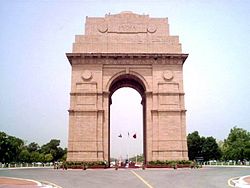Purana Qila ramparts, and lake outside it, Delhi
Purana Qila (Hindi: पुराना क़िला, Urdu: پُرانا قلعہ, translation: Old Fort), is the inner citadel of the city of Dina-panah, founded by the second Mughal Emperor, Humayun in 1533 and completed five years later.Purana Qila and its environs flourished as the sixth city of Delhi.
Sher Shah Suri defeated Humayun in 1540, and renamed the fort as Shergarh, and also added several more structures in the complex, during his reign that lasted for the next five years until his death in 1545.
Subsequently Islam Shah took over the reigns of North India from this fort, but later shifted his capital to Gwalior, as it was supposed to be a safer capital in that period. After Islam Shah's death in 1553, Adil Shah took the charge of North India, and this fort remained neglected. Adil Shah shifted his capital to further east to Chunar in present day Uttar Pradesh. Humayun, who was based in Kabul got an opportunity to re-capture the citadel and the seat of Delhi in 1555, fifteen year after he had to leave it, though his reign didn't last long, he died only a year later in Jan. 1556, due to a tragic accident, within the fort complex at Sher Mandal.
Hearing about re-capture of Delhi by Humanyun, Hemu, the Hindu Prime Minister - cum - Chief of Army of Adil Shah Suri rushed towards Delhi from Bengal, where he had just quelled a rebellion, defeating and killing Muhhamad Shah, the ruler of Bengal. After capturing Agra, Itawah, Kanpur easily, the battle for Delhi took place in Tuglaqabad area on 6th Oct. 1556, and Hemu, who had won 22 battles spanning entire north India, defeated the forces of Akbar which were led by Tardi Beg Khan. Hemu had his 'Rajyabhishake' or Coronation at Purana Quila on 7th Oct. 1556, declared 'Hindu Raj' in North India, and was bestowed the title of Samrat Hem Chandra Vikramaditya. Hemu, who was slain and killed at the Second battle of Panipat in Nov. 1556 had his torso hung outside this fort to create terror among Hindus.
The walls of the Fort rise to a height of 18 mtrs., and run on for about 1.5 km, and has three arched gateways, the Bara Darwaza (Big Gate) facing West, which is still used today, the south gate, the 'Humayun Gate' probably called so because it was constructed by Humayun or that Humayun's Tomb is visible from there, and lastly, the 'Talaqi Gate' or forbidden gate. All the gates are double-storeyed sandstone structures flanked by two huge semi-circular bastion towers, and decorated with white and coloured-marble inlays and blue tiles, and replete with detailing, like ornate overhanging balconies, jharokhas, pillared pavilions chhatris on top, reminiscent of Rajasthani architecture as seen in the North and South Gates, and which were amply seen in future Mughal architecture. Despite the grandeurs of the exterior, few of interior structures have survived except the Qila-i Kuhna Mosque and the Shermandal, both credited to Sher Shah.
Today, it is also the venue of daily sound and light shows after sunset, entailing history of seven cities of Delhi, from Indraprastha to New Delhi.
Indraprastha
Delhi is thought to be located at the site of the legendary city of Indraprastha founded by the Pandavas from Mahabharata period, which is consequently considered the 'First City of Delhi', In support of this, until 1913, a village called Indrapat existed with the fort walls,.
Laxmi Narayan Temple
The temple was built in 1622 by Vir Singh Deo, and renovated by Prithvi Singh in 1793. During 1933-39, Laxmi Narayan Temple was built by Baldeo Das Birla of Birla family. Thus, the temple is also known as Birla Temple. The famous temple is accredited to have been inaugurated by Mahatma Gandhi in 1939. At that time, Mahatma Gandhi kept a condition that the temple would not be restricted to the Hindus and people from every caste would be allowed inside. Since then, funds for further renovations and support have come from the Birla family.
The Laxminarayan Temple (Hindi: श्री लक्ष्मीनारायण मन्दिर, also known as the Birla Mandir) is a Hindu temple dedicated to Laxminarayan in Delhi, India. The temple is built in honour of Lakshmi (Hindu goddess of wealth), and her consort Narayana (Vishnu, Preserver in the Trimurti).
The temple is adorned with many shrines, fountains, and a large garden. The temple is one of the major attractions of Delhi and attracts thousands of devotees on the Hindu festivals of Janmashtami and Diwali
.
India Gate
The India Gate is the national monument of India. Situated in the heart of New Delhi, India Gate was designed by Sir Edwin Lutyens. Originally known as All India War Memorial, it is a prominent landmark in Delhi and commemorates the 90,000 soldiers of the British Indian Army who lost their lives while fighting for the British Indian Empire, or more correctly the British Raj in World War I and the Third Anglo-Afghan War. It is composed of red sand stone and granite.Originally, a Statue of King George V had stood under the now-vacant canopy in front of the India Gate, and was removed to Coronation Park with other statues. Following India's independence, India Gate became the site of the Indian Army's Tomb of the Unknown Soldier, known as the Amar Jawan Jyoti (The flame of the immortal soldier).











0 comments:
Post a Comment